The Use of a Composition of Bacterial Consortia and Living Mulch to Reduce Weeds in Organic Spring Barley Cultivation as an Element of Sustainable Plant Production
Abstract
1. Introduction
2. Materials and Methods
2.1. Field Research Location
2.2. Cultivation Management and Data Collection
2.3. Statistical Analysis
3. Results
3.1. Fresh Matter of Weeds
3.2. Dry Matter of Weeds
3.3. Number of Weeds
3.4. Dominant Weed Species
4. Discussion
5. Conclusions
Author Contributions
Funding
Institutional Review Board Statement
Data Availability Statement
Conflicts of Interest
References
- Sindhu, S.S.; Khandelwal, A.; Phour, M.; Sehrawat, A. Bioherbicidal potential of rhizosphere microorganisms for ecofriendly weeds management. In Agriculturally Important Microbes for Sustainable Agriculture; Applications in Crop Production and Protection; Meena, V.S., Mishra, P.K., Bisht, J.K., Pattanayak, A., Eds.; Springer: Singapore, 2018; pp. 331–376. [Google Scholar] [CrossRef]
- Pavlović, D.; Vrbničanin, S.; Anđelković, A.; Božić, D.; Rajković, M.; Malidža, G. Non-chemical weed control for plant health and environment: Ecological integrated weed management (EIWM). Agronomy 2022, 12, 1091. [Google Scholar] [CrossRef]
- European Commission. The European Green Deal; Communication No. 640, 2019; Commission of European Communities: Brussels, Belgium, 2019. [Google Scholar]
- Pilipavičius, V.; Romaneckienė, R.; Romaneckas, K. The effect of spring barley (Hordeum vulgare L.) sowing rate on the dynamics of crop weediness at different development stages. Žemdirbystė=Agriculture 2011, 98, 111–120. [Google Scholar]
- Petcu, V.; Bărbieru, A.; Popa, M.; Lazăr, C.; Ciornei, L.; Străteanu, A.G.; Todirică, I.C. Early sowing on some soybean genotypes under organic farming conditions. Plants 2023, 12, 2295. [Google Scholar] [CrossRef] [PubMed]
- Peters, K.; Breitsameter, L.; Gerowitt, B. Impact of climate change on weeds in agriculture: A review. Agron. Sustain. Dev. 2014, 34, 707–721. [Google Scholar] [CrossRef]
- Baessler, C.; Klotz, S. Effects of changes in agricultural land-use on landscape structure and arable weed vegetation over the last 50 years. Agric. Ecosyst. Environ. 2006, 115, 43–50. [Google Scholar] [CrossRef]
- Peters, K.; Porembski, S.; Gerowitt, B. Entwicklung, Samenbildung und Biomasseproduktion ausgewählter Problemunkrautarten w Rapshalbzwerghybriden. Gesunde Pflanz. 2009, 61, 101–106. [Google Scholar] [CrossRef]
- Meissle, M.; Mouron, P.; Musa, T.; Bigler, F.; Pons, X.; Vasileiadis, V.P.; Otto, S.; Kiss, J.; Pálinkás, Z.; Dorner, Z.; et al. Pests, pesticide use and alternative options in European maize production: Current status and future prospects. J. Appl. Entomol. 2010, 134, 357–375. [Google Scholar] [CrossRef]
- Reed, L.; Glick, B.R. The recent use of plant-growth-promoting bacteria to promote the growth of agricultural food crops. Agriculture 2023, 13, 1089. [Google Scholar] [CrossRef]
- Glick, B.R. Beneficial Plant-Bacterial Interactions, 2nd ed.; Springer: Berlin/Heidelberg, Germany, 2020; p. 383. [Google Scholar]
- Olanrewaju, O.S.; Glick, B.R.; Babalola, O.O. Mechanisms of action of plant growth promoting bacteria. World J. Microbiol. Biotechnol. 2017, 33, 197. [Google Scholar] [CrossRef]
- Baris, O.; Sahin, F.; Turan, M.; Orhan, F.; Gulluce, M. Use of plant-growth-promoting rhizobacteria (PGPR) seed inoculation as alternative fertilizer inputs in wheat and barley production. Commun. Soil Sci. Plant Anal. 2014, 45, 2457–2467. [Google Scholar] [CrossRef]
- Artyszak, A.; Gozdowski, D. Application of growth activators and Plant Growth-Promoting Rhizobacteria as a method of introducing a “farm to fork” strategy in crop management of winter oilseed. Sustainability 2021, 13, 3562. [Google Scholar] [CrossRef]
- Cinkocki, R.; Lipková, N.; Javoreková, S.; Petrová, J.; Maková, J.; Medo, J.; Ducsay, L. The impact of growth-promoting streptomycetes isolated from rhizosphere and bulk soil on oilseed rape (Brassica napus L.) growth parameters. Sustainability 2021, 13, 5704. [Google Scholar] [CrossRef]
- Mustafa, A.; Naveed, M.; Saeed, Q.; Nadeem Ashraf, M.; Hussain, A.; Abbas, T.; Kamran, M.; Sun, N.; Xu, M. Application potentials of plant growth promoting rhizobacteria and fungi as an alternative to conventional weed control methods. In Sustainable Crop Production; IntechOpen: London, UK, 2019. [Google Scholar] [CrossRef]
- Olsen, J.; Kristensen, L.; Weiner, J. Effects of density and spatial pattern of winter wheat on suppression of different weed species. Weed Sci. 2005, 53, 690–694. [Google Scholar] [CrossRef]
- Dahiya, A.; Sharma, R.; Sindhu, S.; Sindhu, S.S. Resource partitioning in the rhizosphere by inoculated Bacillus spp. towards growth stimulation of wheat and suppression of wild oat (Avena fatua L.) weed. Physiol. Mol. Biol. Plants 2019, 25, 1483–1495. [Google Scholar] [CrossRef]
- Ahemad, M.; Kibret, M. Mechanisms and applications of plant growth promoting rhizobacteria: Current perspective. J. King Saud Univ.-Sci. 2014, 26, 1–20. [Google Scholar] [CrossRef]
- Phour, M.; Sindhu, S.S. Bio-herbicidal effect of 5-aminolevulinic acid producing rhizobacteria in suppression of Lathyrus aphaca weed growth. BioControl 2019, 64, 221–232. [Google Scholar] [CrossRef]
- Herrera, J.M.; Rubio, G.; Häner, L.L.; Delgado, J.A.; Lucho-Constantino, C.A.; Islas-Valdez, S.; Pellet, D. Emerging and established technologies to increase nitrogen use efficiency of cereals. Agronomy 2016, 6, 25. [Google Scholar] [CrossRef]
- Vandana Devi, V.S.; Raj, S.K.; Sreekumar, A.; Sherafudeen, H. A review on live mulch for better agriculture. Environ. Ecol. 2023, 41, 2452–2459. [Google Scholar] [CrossRef]
- Médiène, S.; Valantin-Morison, M.; Sarthou, J.-P.; De Tourdonnet, S.; Gosme, M.; Bertrand, M.; Roger-Estrade, J.; Aubertot, J.-N.; Rusch, A.; Motisi, N.; et al. Agroecosystem management and biotic interactions: A review. Agron. Sustain. Dev. 2011, 31, 491–514. [Google Scholar] [CrossRef]
- Dzvene, A.R.; Tesfuhuney, W.A.; Walker, S.; Ceronio, G. management of cover crop intercropping for live mulch on plant productivity and growth resources: A review. Air Soil Water Res. 2023, 16. [Google Scholar] [CrossRef]
- Westbrook, A.S.; Bhaskar, V.; DiTommaso, A. Weed control and community composition in living mulch systems. Weed Res. 2022, 62, 12–23. [Google Scholar] [CrossRef]
- Osipitan, O.A.; Dille, J.A.; Assefa, Y.; Knezevic, S.Z. Cover crop for early season weed suppression in crops: Systematic review and meta-analysis. Agron. J. 2018, 110, 2211–2221. [Google Scholar] [CrossRef]
- Vincent-Caboud, L.; Vereecke, L.; Silva, E.; Peigné, J. Cover crop effectiveness varies in cover crop-based rotational tillage organic soybean systems depending on species and environment. Agronomy 2019, 9, 319. [Google Scholar] [CrossRef]
- Bhaskar, V.; Westbrook, A.S.; Bellinder, R.R.; DiTommaso, A. Integrated management of living mulches for weed control: A review. Weed Technol. 2021, 35, 856–868. [Google Scholar] [CrossRef]
- Leoni, F.; Lazzaro, M.; Carlesi, S.; Moonen, A.-C. Legume ecotypes and commercial cultivars differ in performance and potential suitability for use as permanent living mulch in Mediterranean vegetable systems. Agronomy 2020, 10, 1836. [Google Scholar] [CrossRef]
- Sjursen, H.; Brandsæter, L.O.; Netland, J. Effects of repeated clover undersowing, green manure ley and weed harrowing on weeds and yields in organic cereals. Acta Agric. Scand. Sect. B—Soil Plant Sci. 2012, 62, 138–150. [Google Scholar] [CrossRef]
- Marcinkevičienė, A.; Čmukas, A.; Velička, R.; Kosteckas, R.; Skinulienė, L. Comparative analysis of undersown cover crops and bio-preparations on weed spread and organically grown spring oilseed rape yield. Sustainability 2023, 15, 13594. [Google Scholar] [CrossRef]
- Salonen, J.; Ketoja, E. Undersown cover crops have limited weed suppression potential when reducing tillage intensity in organically grown cereals. Org. Agric. 2020, 10, 107–121. [Google Scholar] [CrossRef]
- Wacławowicz, R.; Giemza, M.; Pytlarz, E.; Wenda-Piesik, A. The impact of cultivation systems on weed suppression and the canopy architecture of spring barley. Agriculture 2023, 13, 1747. [Google Scholar] [CrossRef]
- Mahajan, G.; Hickey, L.; Chauhan, B.S. response of barley genotypes to weed interference in Australia. Agronomy 2020, 10, 99. [Google Scholar] [CrossRef]
- Mason, H.E.; Navabi, A.; Frick, B.L.; O’Donovan, J.T.; Spaner, D.M. The weed-competitive ability of Canada western red spring wheat cultivars grown under organic management. Crop Sci. 2007, 47, 1167–1176. [Google Scholar] [CrossRef]
- Abbas, T.; Naveed, M.; Siddique, S.; Aziz, M.Z.; Khan, K.S.; Zhang, J.J.; Mustafa, A.; Sardar, M.F. Biological weeds control in rice (Oryza sativa) using beneficial plant growth promoting rhizobacteria. Int. J. Agric. Biol. 2020, 23, 552–558. [Google Scholar]
- Dar, A.; Zahir, Z.A.; Asghar, H.N.; Ahmad, R. Preliminary screening of rhizobacteria for biocontrol of little seed canary grass (Phalaris minor Retz.) and wild oat (Avena fatua L.) in wheat. Can. J. Microbiol. 2020, 66, 368–376. [Google Scholar] [CrossRef] [PubMed]
- Radhakrishnan, R.; Park, J.; Lee, I.J.; Abd Allah, E.F.; Hashem, A. Bio-herbicide effect of salt marsh tolerant Enterobacter sp. i-3 on weed seed germination and seedling growth. Pak. J. Bot. 2017, 49, 1959–1963. [Google Scholar]
- Kremer, R.J.; Souissi, T. Cyanide production by rhizobacteria and potential for suppression of weed seedling growth. Curr. Microbiol. 2001, 43, 182–186. [Google Scholar] [CrossRef] [PubMed]
- Abbas, T.; Zahir, A.Z.; Naveed, M. Bioherbicidal activity of allelopathic bacteria against weeds associated with wheat and their effects on growth of wheat under axenic conditions. BioControl 2017, 62, 719–730. [Google Scholar] [CrossRef]
- Hashem, A.; Tabassum, B.; Fathi Abd Allah, E. Bacillus subtilis: A plant-growth promoting rhizobacterium that also impacts biotic stress. Saudi J. Biol. Sci. 2019, 26, 1291–1297. [Google Scholar] [CrossRef] [PubMed]
- Ladha, J.K.; Peoples, M.B.; Reddy, P.M.; Biswas, J.C.; Bennett, A.; Jat, M.L.; Krupnik, T.J. Biological nitrogen fixation and prospects for ecological intensification in cereal-based cropping systems. Field Crops Res. 2022, 283, 108541. [Google Scholar] [CrossRef] [PubMed]
- Minuț, M.; Diaconu, M.; Roșca, M.; Cozma, P.; Bulgariu, L.; Gavrilescu, M. Screening of Azotobacter, Bacillus and Pseudomonas species as plant growth-promoting bacteria. Processes 2023, 11, 80. [Google Scholar] [CrossRef]
- Sati, D.; Pande, V.; Pandey, S.C.; Samant, M. Recent advances in PGPR and molecular mechanisms involved in drought stress resistance. J. Soil Sci. Plant Nutr. 2023, 23, 106–124. [Google Scholar] [CrossRef]
- Bouremani, N.; Cherif-Silini, H.; Silini, A.; Bouket, A.C.; Luptakova, L.; Alenezi, F.N.; Baranov, O.; Belbahri, L. Plant Growth-Promoting Rhizobacteria (PGPR): A Rampart against the adverse effects of drought stress. Water 2023, 15, 418. [Google Scholar] [CrossRef]
- Płaza, A.; Niewiadomska, A.; Górski, R.; Rosa, R. A combination of bacterial products and cover crops as an innovative method of weed control in organic spring barley. J. Plant Prot. Res. 2023, 63, 196–207. [Google Scholar] [CrossRef]
- Weissmann, R.; Uggla, C.; Gerhardson, B. Field performance of a weed-suppressing Serratia plymuthica strain applied with conventional spraying equipment. BioControl 2003, 48, 725–742. [Google Scholar] [CrossRef]
- Li, J.; Kremer, R.J. Growth response of weed and crop seedlings to deleterious rhizobacteria. Biol. Control 2006, 39, 58–65. [Google Scholar] [CrossRef]
- Zermane, N.; Souissi, T.; Kroschel, J.; Sikora, R. Biocontrol of broom rape (Orobanche crenata Forsk. and Orobanche foetida Poir.) by Pseudomonas fluorescens isolate Bf7-9 from the faba bean rhizosphere. Biocontrol Sci. Technol. 2007, 17, 487–497. [Google Scholar] [CrossRef]
- Khazaie, M.; Taab, A. Study the possibility of using undersown persian clover in oilseed rape for weed control. J. Crops Improv. 2019, 21, 337–458. [Google Scholar]
- Gerhards, R. Weed suppression ability and yield impact of living mulch in cereal crops. Agriculture 2018, 8, 39. [Google Scholar] [CrossRef]
- Petit, S.; Cordeau, S.; Chauvel, B.; Bohan, D.; Guillemin, J.-P.; Steinberg, C. Biodiversity-based options for arable weed management. A review. Agron. Sustain. Dev. 2018, 38, 48. [Google Scholar] [CrossRef]
- Juroszek, P.; Gerhards, R. Photocontrol of weeds. J. Agron. Crop Sci. 2004, 190, 402–415. [Google Scholar] [CrossRef]
- Liebman, M.; Mohler, C.L.; Staver, C.P. Ecological Management of Agricultural Weeds; Cambridge University Press: Cambridge, UK, 2001; 532p. [Google Scholar]
- Shili-Touzi, I. Analyze du Fonctionnement d’une Association de blé d’hiver (Triticum aestivum L.) et d’une Plante de Couverture sur une Échelle Annuelle par Modélisation et Experimentation. Ph.D. Thesis, AgroParisTech, Paris, France, 2009. [Google Scholar]
- Teasdale, J.R.; Brandsæter, L.O.; Calegari, A.; Skora Neto, F. Cover crops and weed management. In Non-Chemical Weed Management: Principles, Concepts and Technology; Upadhyaya, M.K., Blackshaw, R.E., Eds.; CABI: Wallingford, UK, 2007; pp. 49–64. [Google Scholar]
- Brainard, D.C.; Bakker, J.; Noyes, D.C.; Myers, N. Rye living mulch effects on soil moisture and weeds in asparagus. HortScience 2012, 47, 58–63. [Google Scholar] [CrossRef]
- Ziyomo, C.; Albrecht, K.A.; Baker, J.M.; Bernardo, R. Corn performance under managed drought stress and in a kura clover living mulch intercropping system. Agron. J. 2013, 105, 579–586. [Google Scholar] [CrossRef]
- Walters, S.A.; Young, B.G. Utility of winter rye living mulch for weed management in zucchini squash production. Weed Technol. 2008, 22, 724–728. [Google Scholar] [CrossRef]
- Baraibar, B.; Mortensen, D.A.; Hunter, M.C.; Barbercheck, M.E.; Kaye, J.P.; Finney, D.M.; Curran, W.S.; Bunchek, J.; White, C.M. Growing degree days and cover crop type explain weed biomass in winter cover crops. Agron. Sustain. Dev. 2018, 38, 65. [Google Scholar] [CrossRef]
- Restuccia, A.; Scavo, A.; Lombardo, S.; Pandino, G.; Fontanazza, S.; Anastasi, U.; Abbate, C.; Mauromicale, G. Long-Term effect of cover crops on species abundance and diversity of weed flora. Plants 2020, 9, 1506. [Google Scholar] [CrossRef] [PubMed]
- Tarrant, A.R.; Brainard, D.C.; Hayden, Z.D. Cover crop performance between plastic-mulched beds: Impacts on weeds and soil resources. HortScience 2020, 55, 1069–1077. [Google Scholar] [CrossRef]
- Stajković-Srbinović, O.; Delić, D.; Kuzmanović, D.; Sikirić, B.; Rasulić, N.; Nikolić, B.; Knežević-Vukčević, J. Growth and nutrient uptake of orchardgrass (Dactylis glomerata L.) and meadow fescue (Festuca pratensis Huds.) as affected by rhizobacteria. Not. Bot. Horti Agrobot. Cluj-Napoca 2016, 44, 296–301. [Google Scholar] [CrossRef][Green Version]
- Karlicic, V.M.; Radic, D.; Petrović, J.J.; Raičević, V. Red clover and plant growth promoting bacteria: The combination that can speed up soil remediation rate. J. Agric. Sci. 2020, 65. [Google Scholar]
- Cortés-Patiño, S.; Vargas, C.; Álvarez-Flórez, F.; Bonilla, R.; Estrada-Bonilla, G. Potential of Herbaspirillum and Azospirillum consortium to promote growth of perennial ryegrass under water deficit. Microorganisms 2021, 9, 91. [Google Scholar] [CrossRef] [PubMed]
- Kosinski, M.S.; King, J.R.; Harker, K.N.; Turkington, T.K.; Spaner, D. Barley and triticale underseeded with a kura clover living mulch: Effects on weed pressure, disease incidence, silage yield, and forage quality. Can. J. Plant Sci. 2011, 91, 667–687. [Google Scholar] [CrossRef]
- DuPre, M.E.; Seipel, T.; Bourgault, M.; Boss, D.L.; Menalled, F.D. Predicted climate conditions and cover crop composition modify weed communities in semiarid agroecosystems. Weed Res. 2022, 62, 38–48. [Google Scholar] [CrossRef]
- Seipel, T.; Ishaq, S.L.; Larson, C.; Menalled, F.D. Weed communities in winter wheat: Responses to cropping systems under different climatic conditions. Sustainability 2022, 14, 6880. [Google Scholar] [CrossRef]
- Ziska, L.H.; Blumenthal, D.M.; Franks, S.J. Understanding the nexus of rising CO2, climate change, and evolution in weed biology. Invasive Plant Sci. Manag. 2019, 12, 79–88. [Google Scholar] [CrossRef]
- Hanzlik, K.; Gerowitt, B. Occurrence and distribution of important weed species in German winter oilseed rape fields. J. Plant Dis. Prot. 2012, 119, 107–120. [Google Scholar] [CrossRef]
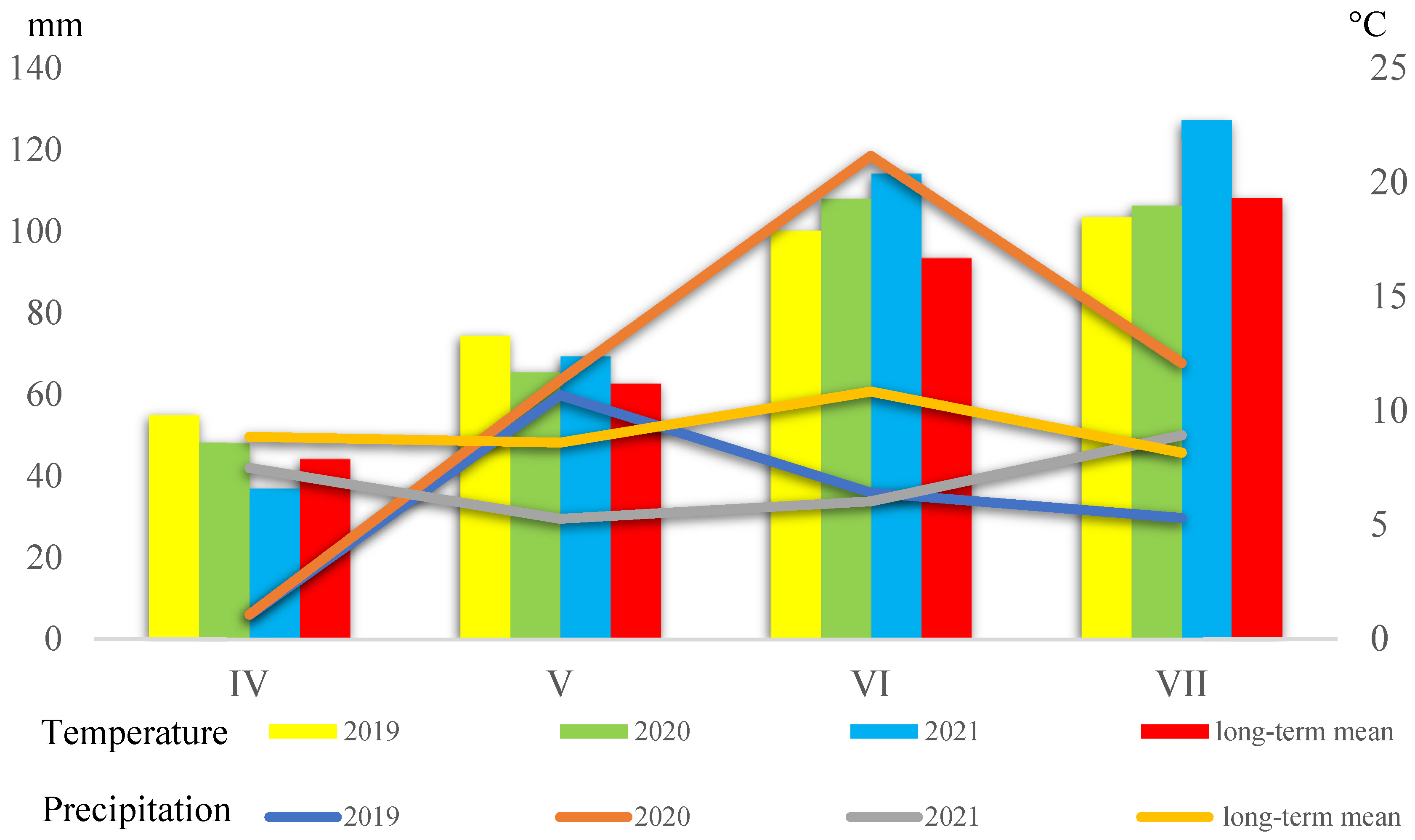
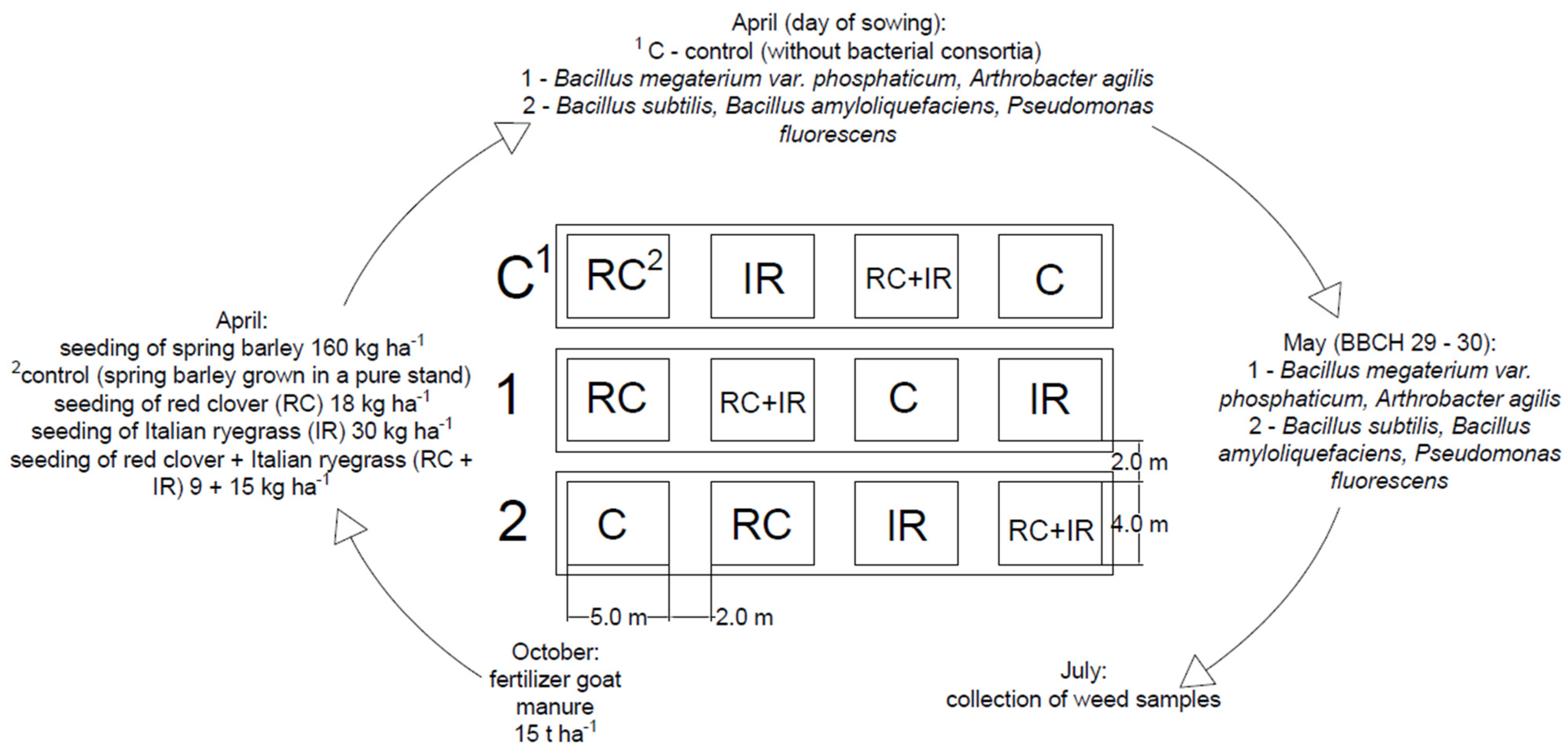
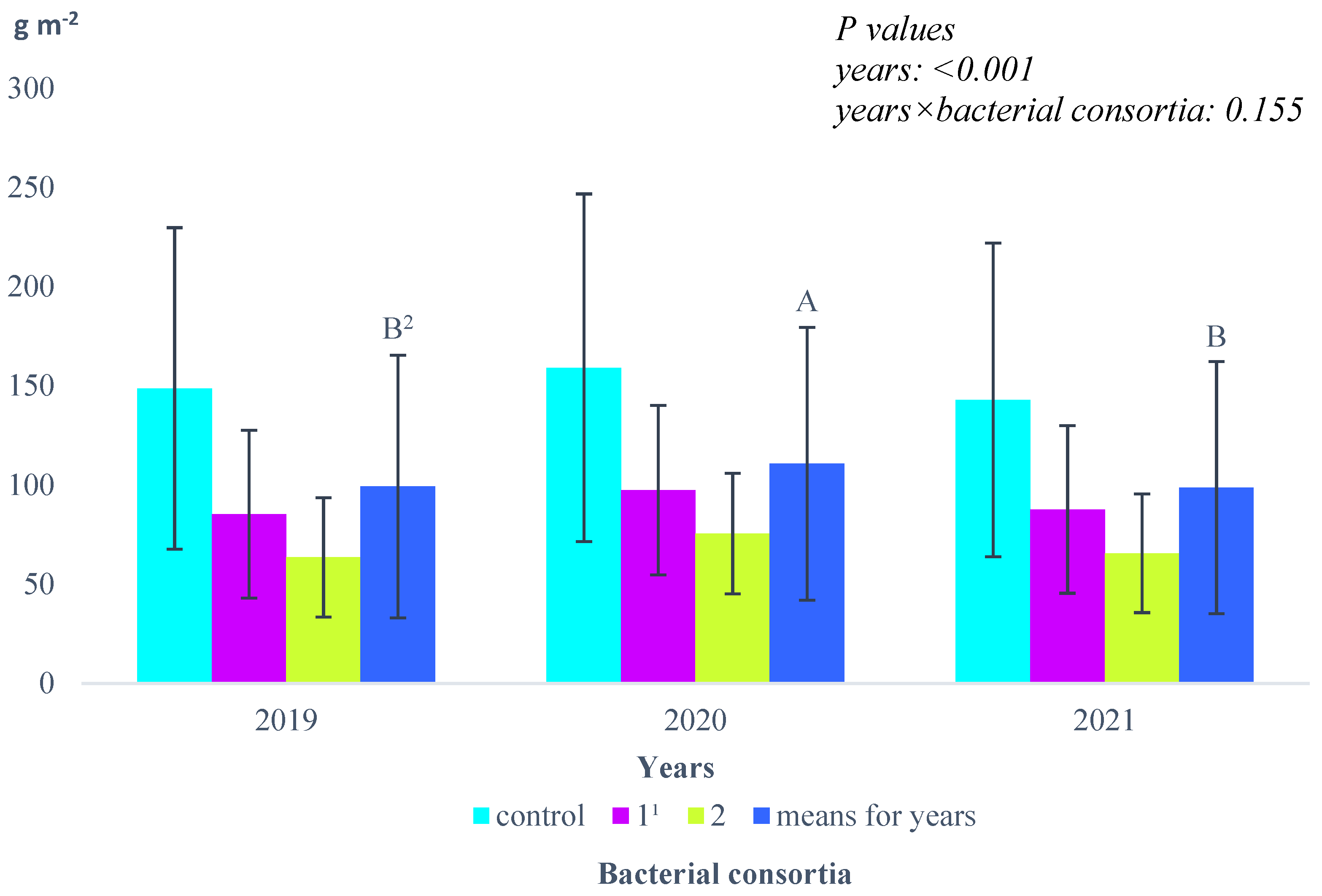
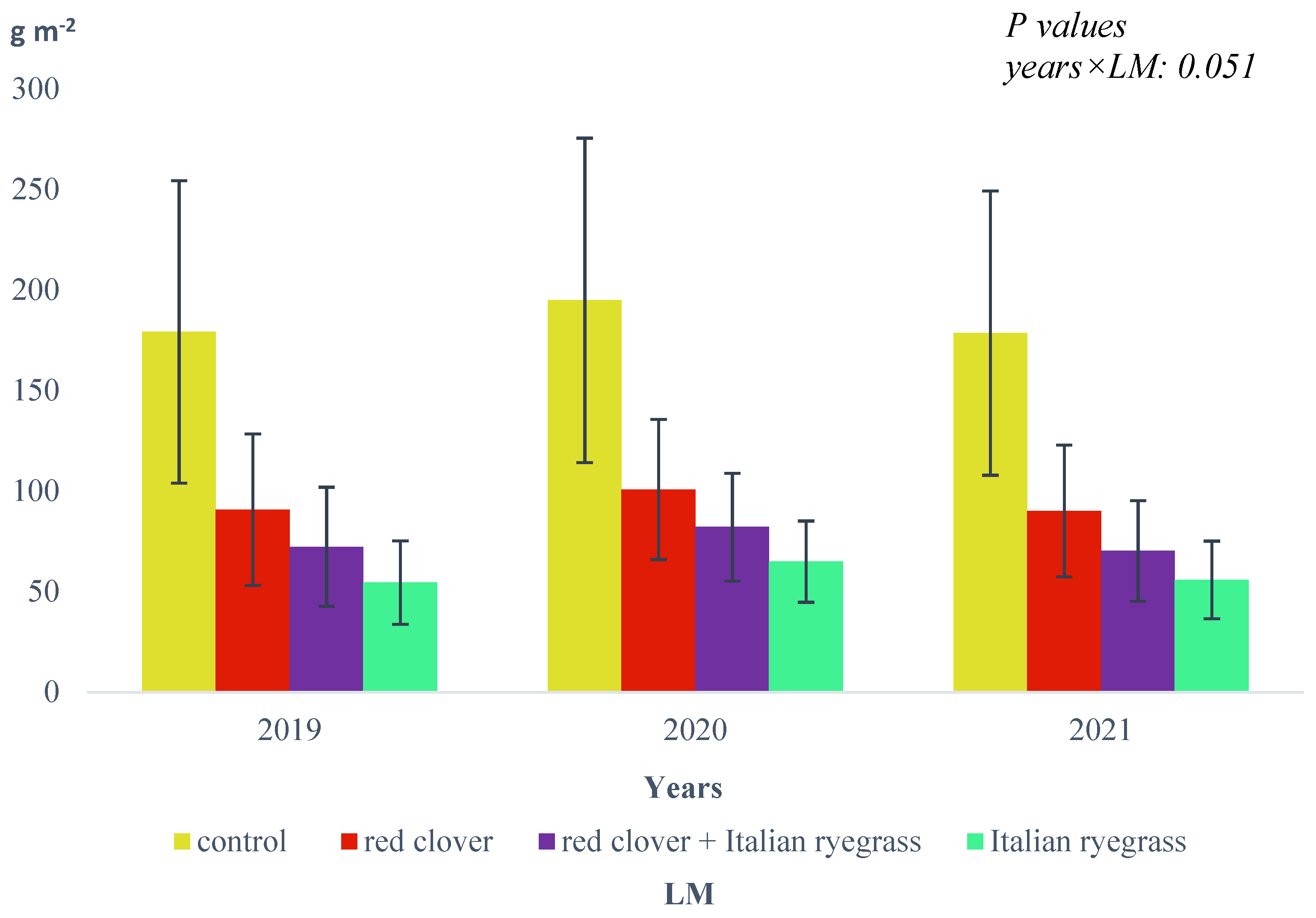
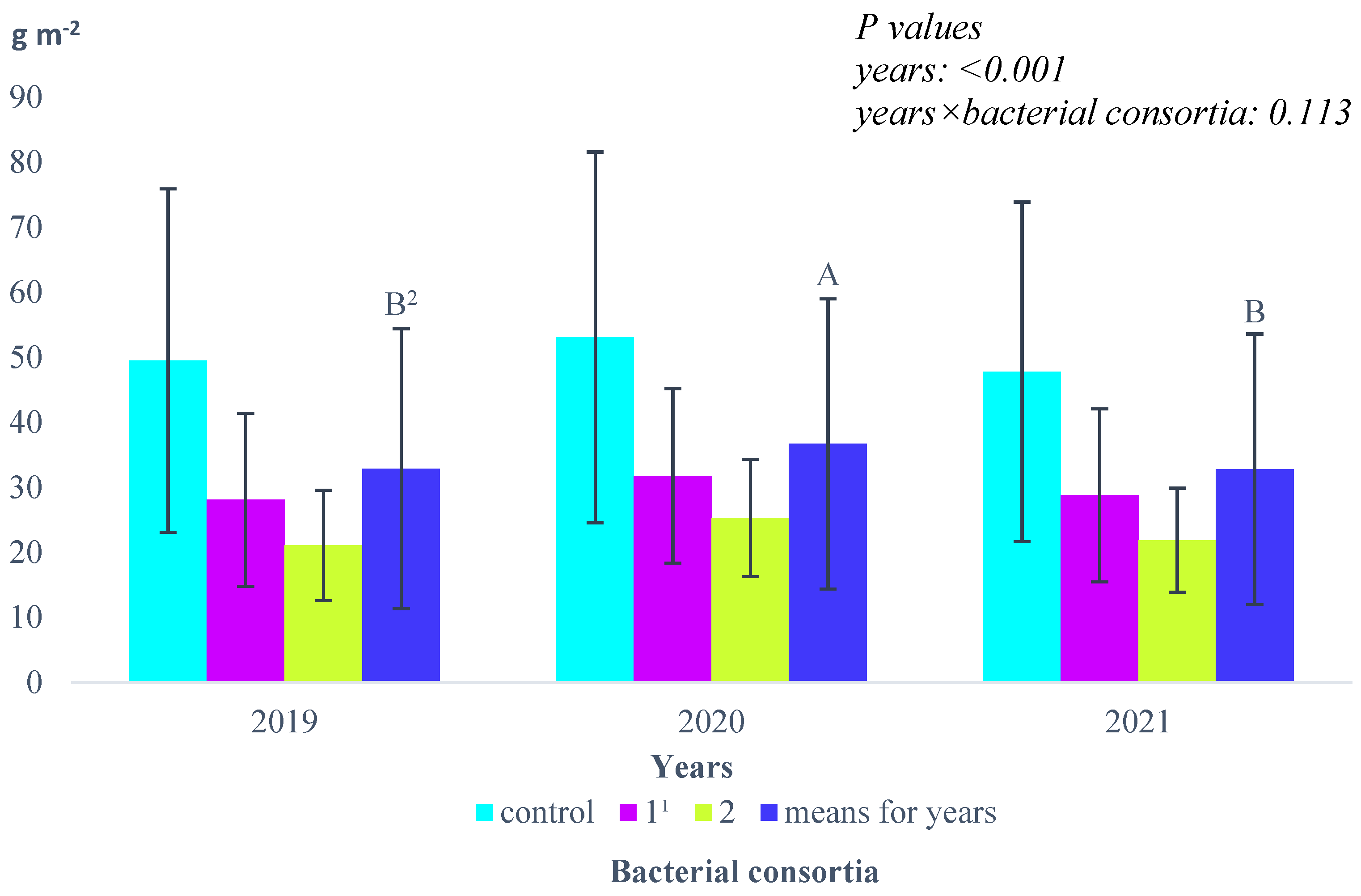
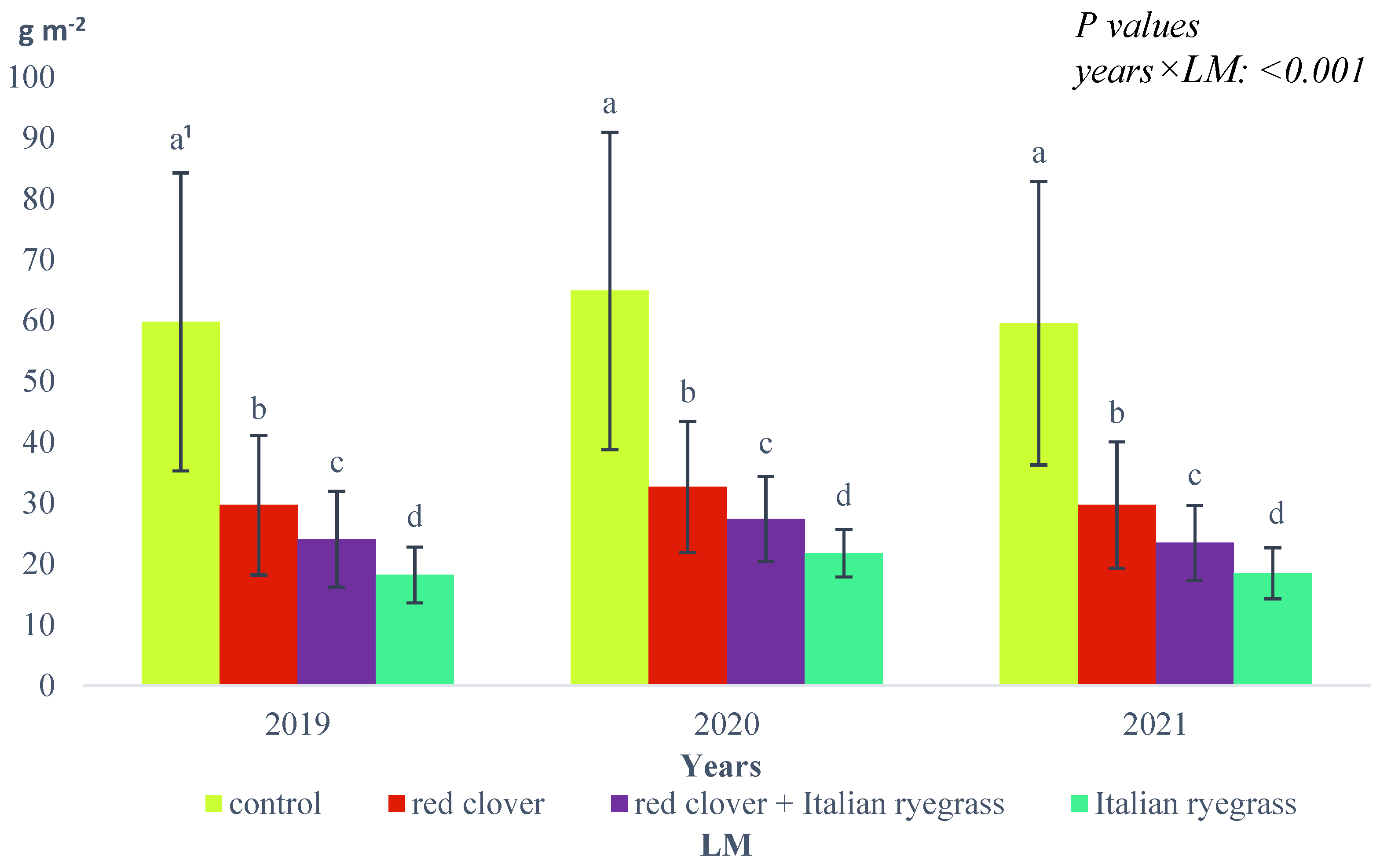

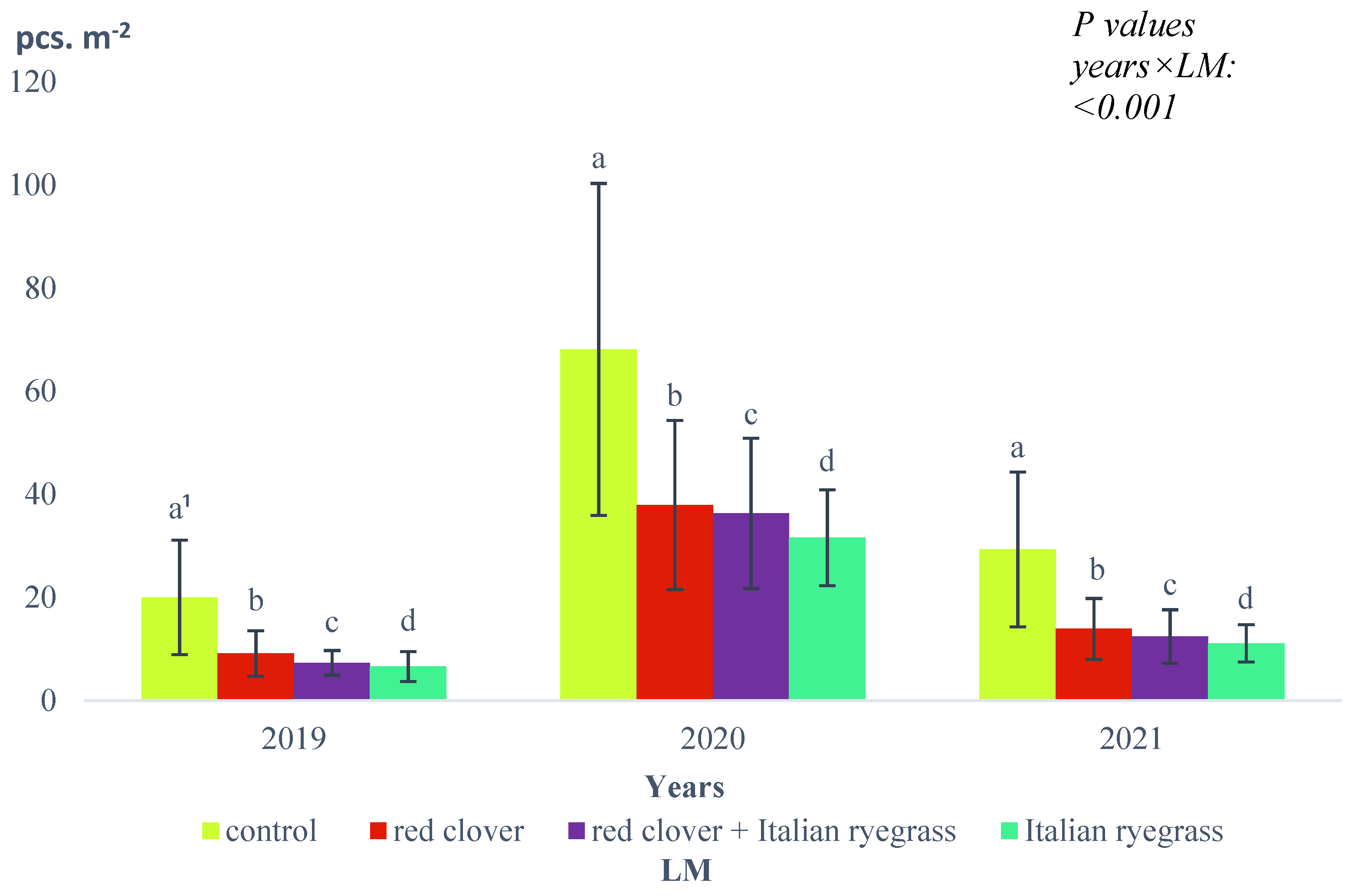
| Factor | Years | Means | ||
|---|---|---|---|---|
| 2019 | 2020 | 2021 | ||
| pH | 6.1 | 6.1 | 6.2 | 6.1 |
| Organic carbon (% d.m.) | 1.04 | 1.04 | 1.07 | 1.05 |
| P (mg 100 g−1 soil) | 8.2 | 8.4 | 8.3 | 8.3 |
| K (mg 100 g−1 soil) | 12.1 | 12.2 | 12.0 | 12.1 |
| Mg (mg 100 g−1 soil) | 4.1 | 4.1 | 4.4 | 4.2 |
| Bacterial Consortia | LM | Means | |||
|---|---|---|---|---|---|
| Control | Red Clover | Red Clover + Italian Ryegrass | Italian Ryegrass | ||
| Control | 284.9 ± 22.4 a 2 | 136.9 ± 17.0 b | 103.0 ± 19.4 c | 76.0 ± 16.6 c | 150.2 ± 82.9 A |
| 1 1 | 156.2 ± 16.7 a | 82.7 ± 14.2 b | 69.3 ± 12.9 b | 52.3 ± 15.5 b | 90.1 ± 42.7 B |
| 2 | 111.3 ± 16.2 a | 62.1 ± 17.2 b | 52.4 ± 15.3 b | 46.9 ± 16.7 b | 68.2 ± 30.6 C |
| Means | 184.1 ± 75.9 A | 93.9 ± 35.4 B | 74.9 ± 27.7 C | 58.4 ± 20.6 D | |
| p-values | bacterial consortia: <0.001; LM: <0.001 bacterial consortia × LM: <0.001 | ||||
| Bacterial Consortia | LM | Means | |||
|---|---|---|---|---|---|
| Control | Red Clover | Red Clover + Italian Ryegrass | Italian Ryegrass | ||
| Control | 95.1 ± 18.5 a 2 | 45.8 ± 10.1 b | 34.3 ± 7.9 c | 25.3 ± 2.3 c | 50.1 ± 27.1 A |
| 1 1 | 52.1 ± 13.2 a | 25.6 ± 8.4 b | 23.2 ± 8.5 b | 17.4 ± 1.9 b | 29.6 ± 13.4 B |
| 2 | 37.2 ± 7.6 a | 20.8 ± 5.1 b | 17.4 ± 2.3 b | 15.8 ± 1.8 b | 22.8 ± 8.7 C |
| Means | 61.4 ± 24.8 A | 30.7 ± 11.0 B | 25.0 ± 9.1 C | 19.5 ± 4.5 D | |
| p-values | bacterial consortia: <0.001; LM: <0.001 bacterial consortia × LM: <0.001 | ||||
| Bacterial Consortia | LM | Means | |||
|---|---|---|---|---|---|
| Control | Red Clover | Red Clover + Italian Ryegrass | Italian Ryegrass | ||
| Control | 66.4 ± 33.8 a 2 | 32.5 ± 20.1 b | 29.0 ± 15.4 b | 23.6 ± 14.8 b | 37.9 ± 19.8 A |
| 1 1 | 27.7 ± 15.7 a | 16.9 ± 10.0 ab | 13.8 ± 8.8 b | 14.1 ± 6.9 b | 18.1 ± 9.1 B |
| 2 | 23.2 ± 13.1 a | 11.6 ± 7.8 b | 13.2 ± 9.1a b | 11.6 ± 7.1 b | 14.9 ± 9.4 C |
| Means | 39.1 ± 20.8 A | 20.3 ± 11.9 B | 18.7 ± 10.6 C | 16.4 ± 11.2 D | |
| p-values | bacterial consortia: <0.001; LM: <0.001 bacterial consortia × LM: <0.001 | ||||
| Spring Barley Yield | p-Values | |
|---|---|---|
| FM of weed | −0.2615 | 0.002 |
| DM of weed | −0.2919 | 0.006 |
| Number of weeds | 0.0933 | 0.337 |
| Bacterial Consortia | LM | Chenopodium album | Sinapis arvensis | Tripleurospermum inodorum | Elymus repens | ||||
|---|---|---|---|---|---|---|---|---|---|
| Means for Bacterial Consortia | Means for Bacterial Consortia | Means for Bacterial Consortia | Means for Bacterial Consortia | ||||||
| Control | Control | 24.4 ± 14.0 a 2 | 11.9 ± 8.7 A | 19.4 ± 8.1 a | 10.2 ± 8.5 A | 13.4 ± 8.0 a | 6.2 ± 3.5 A | 4.9 ± 3.4 c | 6.3 ± 4.8 A |
| Red clover | 11.0 ± 5.9 b | 9.6 ± 7.5 b | 4.8 ± 3.2 b | 4.1 ± 3.2 c | |||||
| Red clover + Italian ryegrass | 8.2 ± 5.9 bc | 7.4 ± 5.5 b | 4.0 ± 3.1 b | 6.9 ± 4.9 b | |||||
| Italian ryegrass | 4.1 ± 2.5 c | 4.6 ± 3.1 c | 2.6 ± 1.8 b | 9.5 ± 5.5 a | |||||
| 1 1 | Control | 6.3 ± 4.4 a | 4.4 ± 2.9 B | 11.3 ± 5.3 a | 6.0 ± 4.9 B | 5.3 ± 3.8 a | 3.2 ± 2.4 B | 2.4 ± 1.7 a | 2.7 ± 2.1 C |
| Red clover | 4.4 ± 2.4 a | 5.4 ± 3.7 b | 3.4 ± 2.2 a | 2.3 ± 1.7 a | |||||
| Red clover + Italian ryegrass | 3.6 ± 2.2 a | 3.6 ± 2.8 b | 2.6 ± 1.7 a | 2.6 ± 1.5 a | |||||
| Italian ryegrass | 3.4 ± 2.4 a | 3.7 ± 2.4 b | 1.4 ± 0.6 b | 3.5 ± 2.6 a | |||||
| 2 | Control | 8.6 ± 5.3 a | 4.1 ± 3.0 B | 7.4 ± 5.1 a | 4.0 ± 2.8 C | 4.2 ± 2.8 a | 2.6 ± 1.9 C | 2.3 ± 1.7 c | 3.3 ± 2.8 B |
| Red clover | 3.2 ± 2.2 ab | 2.5 ± 1.7 b | 2.3 ± 1.7 a | 2.6 ± 1.9 bc | |||||
| Red clover + Italian ryegrass | 2.4 ± 1.7 b | 3.4 ± 2.2 b | 2.6 ±1.9 a | 3.7 ± 2.6 ab | |||||
| Italian ryegrass | 2.0 ± 0.9 b | 2.5 ± 1.7 b | 1.2 ± 0.9 a | 4.7 ± 3.7 a | |||||
| Means for LM | Control | 13.1 ± 8.2 A | 12.7 ± 8.0 A | 7.6 ± 4.8 A | 3.2 ± 2.7 C | ||||
| Red clover | 6.2 ± 4.2 B | 5.8 ± 4.1 B | 3.5 ± 2.7 B | 3.0 ± 2.4 C | |||||
| Red clover + Italian ryegrass | 4.7 ± 2.1 C | 4.8 ± 3.6 C | 3.1 ± 2.5 C | 4.4 ± 3.6 B | |||||
| Italian ryegrass | 3.2 ± 2.2 D | 3.6 ± 2.7 D | 1.7 ± 1.2 D | 5.9 ± 4.8 A | |||||
| p-values | Bacterial consortia | <0.001 | <0.001 | <0.001 | <0.001 | ||||
| LM | <0.001 | <0.001 | <0.001 | <0.001 | |||||
| Bacterial consortia × LM | <0.001 | <0.001 | <0.001 | <0.001 | |||||
Disclaimer/Publisher’s Note: The statements, opinions and data contained in all publications are solely those of the individual author(s) and contributor(s) and not of MDPI and/or the editor(s). MDPI and/or the editor(s) disclaim responsibility for any injury to people or property resulting from any ideas, methods, instructions or products referred to in the content. |
© 2024 by the authors. Licensee MDPI, Basel, Switzerland. This article is an open access article distributed under the terms and conditions of the Creative Commons Attribution (CC BY) license (https://creativecommons.org/licenses/by/4.0/).
Share and Cite
Górski, R.; Rosa, R.; Niewiadomska, A.; Wolna-Maruwka, A.; Głuchowska, K.; Płaza, A. The Use of a Composition of Bacterial Consortia and Living Mulch to Reduce Weeds in Organic Spring Barley Cultivation as an Element of Sustainable Plant Production. Sustainability 2024, 16, 5268. https://doi.org/10.3390/su16125268
Górski R, Rosa R, Niewiadomska A, Wolna-Maruwka A, Głuchowska K, Płaza A. The Use of a Composition of Bacterial Consortia and Living Mulch to Reduce Weeds in Organic Spring Barley Cultivation as an Element of Sustainable Plant Production. Sustainability. 2024; 16(12):5268. https://doi.org/10.3390/su16125268
Chicago/Turabian StyleGórski, Rafał, Robert Rosa, Alicja Niewiadomska, Agnieszka Wolna-Maruwka, Katarzyna Głuchowska, and Anna Płaza. 2024. "The Use of a Composition of Bacterial Consortia and Living Mulch to Reduce Weeds in Organic Spring Barley Cultivation as an Element of Sustainable Plant Production" Sustainability 16, no. 12: 5268. https://doi.org/10.3390/su16125268
APA StyleGórski, R., Rosa, R., Niewiadomska, A., Wolna-Maruwka, A., Głuchowska, K., & Płaza, A. (2024). The Use of a Composition of Bacterial Consortia and Living Mulch to Reduce Weeds in Organic Spring Barley Cultivation as an Element of Sustainable Plant Production. Sustainability, 16(12), 5268. https://doi.org/10.3390/su16125268








